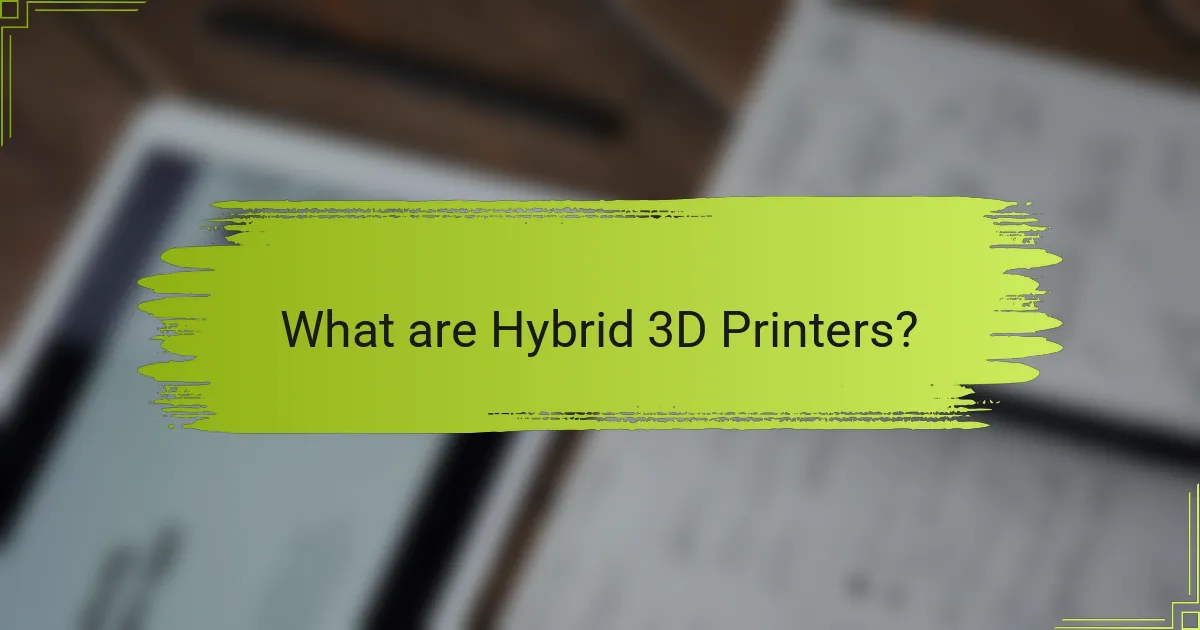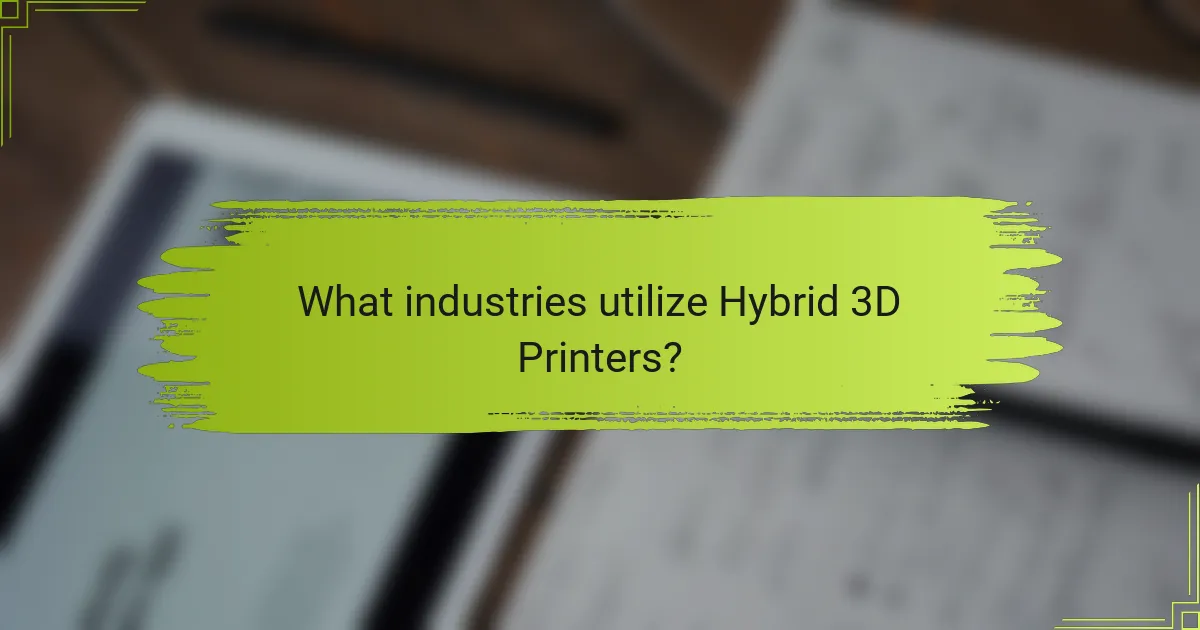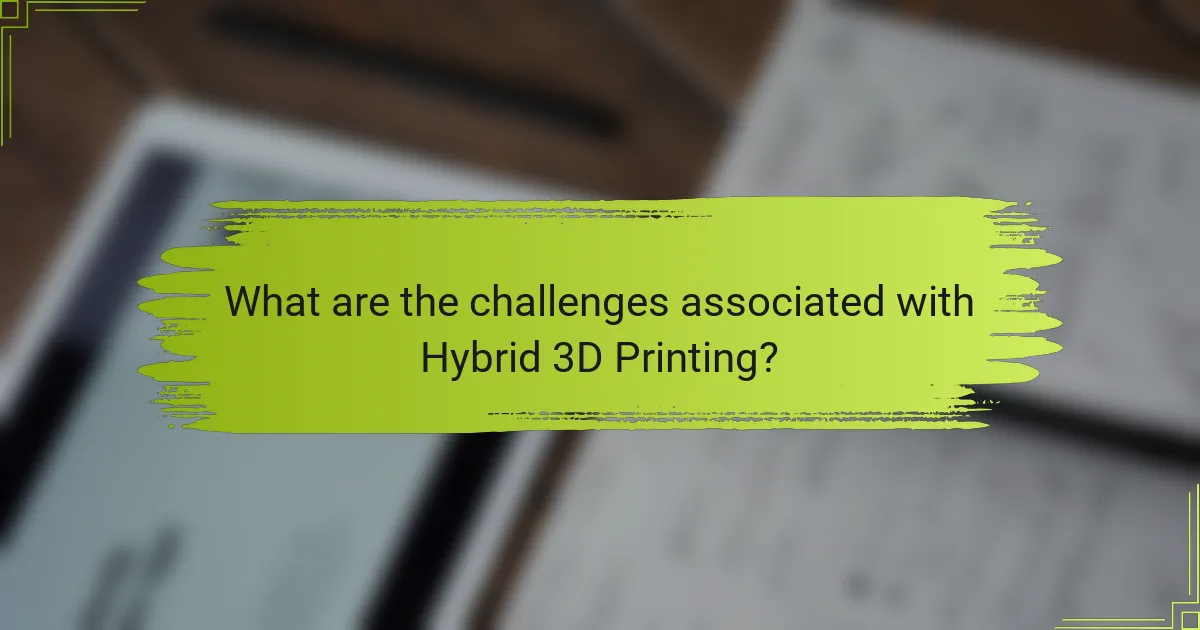
What are Hybrid 3D Printers?
Hybrid 3D printers are advanced manufacturing devices that combine additive and subtractive manufacturing processes. They utilize both 3D printing techniques and traditional machining methods. This integration allows for the creation of complex geometries while also enabling precise finishing. Hybrid 3D printers can produce parts with intricate details and high tolerances. They are often used in industries such as aerospace and automotive for prototyping and production. The ability to switch between processes enhances efficiency and reduces material waste. This technology is gaining traction due to its versatility and capability to streamline production workflows.
How do Hybrid 3D Printers differ from traditional 3D printers?
Hybrid 3D printers combine additive and subtractive manufacturing processes, unlike traditional 3D printers that solely use additive methods. They can print objects and subsequently refine them through machining. This dual capability allows for greater precision and the ability to work with multiple materials. Traditional 3D printers typically lack this versatility. Hybrid models can produce complex geometries that might be challenging for traditional methods. The integration of both processes can reduce production time and waste. Hybrid 3D printers are often used in industries like aerospace and automotive for high-quality parts. This differentiation enhances their application range compared to conventional 3D printing technologies.
What technologies are integrated into Hybrid 3D Printers?
Hybrid 3D printers integrate multiple technologies, primarily combining additive and subtractive manufacturing processes. These printers utilize techniques such as fused deposition modeling (FDM) for additive printing. They also employ computer numerical control (CNC) for subtractive machining. Laser sintering is another technology often integrated for enhanced material processing. Some models incorporate multi-material capabilities, allowing for diverse material use. These technologies enable improved precision and versatility in production. Hybrid 3D printers are designed to optimize the manufacturing workflow. They can create complex geometries while also finishing surfaces through machining. This dual functionality enhances efficiency in various industrial applications.
What are the main components of a Hybrid 3D Printer?
The main components of a Hybrid 3D Printer include a 3D printing head, a milling head, a build platform, and a control system. The 3D printing head is responsible for additive manufacturing processes. It deposits material layer by layer to create objects. The milling head performs subtractive processes to refine and finish the printed parts. The build platform supports the object during both printing and milling operations. The control system coordinates the actions of the printing and milling heads. Together, these components enable the hybrid functionality of the printer, allowing for complex designs and improved surface finishes.
What unique features do Hybrid 3D Printers offer?
Hybrid 3D printers combine additive and subtractive manufacturing processes. They allow for enhanced precision and material versatility. These printers can create complex geometries while also machining parts to exact specifications. This dual capability reduces the need for multiple machines. It streamlines production workflows and minimizes material waste. Hybrid 3D printers are particularly beneficial in aerospace and automotive industries. They enable rapid prototyping and production of functional parts. Their unique features lead to improved design flexibility and efficiency in manufacturing processes.
How does the multi-material capability enhance printing?
Multi-material capability enhances printing by allowing the use of different materials in a single print job. This feature enables the creation of complex geometries and intricate designs. It facilitates the integration of various properties, such as flexibility and rigidity, within one printed object. For example, combining soft and hard materials can produce functional prototypes that better simulate real-world applications. Additionally, multi-material printing reduces the need for assembly, streamlining production processes. This capability also opens avenues for innovative designs that were previously unattainable. The versatility in material selection can lead to improved performance characteristics in the final product. Overall, multi-material capability significantly broadens the scope and functionality of 3D printed items.
What role does automation play in Hybrid 3D Printing?
Automation plays a crucial role in Hybrid 3D Printing by enhancing efficiency and precision. It integrates automated processes for material deposition and post-processing. This reduces manual intervention, leading to faster production cycles. Automation improves consistency in layer alignment and material application. It enables real-time monitoring of print quality and adjustments during the process. Automated systems can also handle complex geometries that would be challenging manually. Research indicates that automation can increase productivity by up to 30% in additive manufacturing environments. Overall, automation significantly optimizes the Hybrid 3D Printing workflow.
What are the benefits of using Hybrid 3D Printers?
Hybrid 3D printers offer enhanced versatility by combining additive and subtractive manufacturing processes. This allows for greater design freedom and the ability to create complex geometries. Users can produce high-precision parts with improved surface finishes. Hybrid 3D printing reduces material waste compared to traditional methods. It also enables faster production times by integrating multiple processes in one machine. Industries benefit from reduced lead times and increased efficiency. Additionally, hybrid systems can utilize a wider range of materials, enhancing the functionality of printed parts. These advantages make hybrid 3D printers increasingly popular in various sectors, including aerospace and automotive.
How do Hybrid 3D Printers improve efficiency in production?
Hybrid 3D printers improve efficiency in production by combining additive and subtractive manufacturing processes. This integration allows for the rapid creation of complex geometries while simultaneously refining surface finishes. Hybrid systems reduce material waste by precisely cutting away excess material after 3D printing. They also enable faster production times, as multiple processes can occur in a single machine. According to a study by the University of Southern California, hybrid manufacturing can decrease lead times by up to 50%. This efficiency leads to lower operational costs and increased throughput in production environments.
What cost savings can be realized with Hybrid 3D Printing?
Hybrid 3D printing can realize significant cost savings by reducing material waste and lowering production times. This technology combines additive and subtractive processes, allowing for efficient use of materials. Studies show that hybrid 3D printing can minimize waste by up to 30% compared to traditional manufacturing methods. Additionally, it can decrease lead times by integrating multiple manufacturing steps into one process. This streamlining can lead to a reduction in labor costs and overall production expenses. Overall, the combination of these factors contributes to substantial cost savings in various industries.

What industries utilize Hybrid 3D Printers?
Hybrid 3D printers are utilized across various industries. Key sectors include aerospace, automotive, healthcare, and manufacturing. In aerospace, these printers create lightweight components with complex geometries. The automotive industry uses them for prototyping and producing end-use parts. Healthcare benefits from hybrid 3D printing in creating custom implants and prosthetics. Manufacturing leverages these printers for tooling and production aids. The versatility of hybrid 3D printing allows for the integration of different materials and processes, enhancing product capabilities. This adaptability drives innovation across these industries, making hybrid 3D printers essential tools.
Which sectors benefit most from Hybrid 3D Printing technology?
Manufacturing, aerospace, automotive, and healthcare sectors benefit most from Hybrid 3D Printing technology. These sectors leverage the unique capabilities of hybrid systems for enhanced production efficiency. In manufacturing, hybrid printing combines additive and subtractive processes, allowing for complex geometries and reduced waste. Aerospace companies utilize hybrid technology to create lightweight components, improving fuel efficiency. The automotive sector benefits from rapid prototyping and customization, leading to faster product development cycles. Healthcare applications include creating patient-specific implants and prosthetics, enhancing surgical outcomes. Each sector sees significant advancements in innovation and cost-effectiveness through hybrid 3D printing.
How is Hybrid 3D Printing applied in aerospace manufacturing?
Hybrid 3D printing is applied in aerospace manufacturing to enhance production efficiency and material properties. It combines additive manufacturing techniques with traditional subtractive processes. This approach allows for the creation of complex geometries that are lightweight yet structurally sound. Aerospace components produced using hybrid 3D printing can achieve higher performance standards. For instance, integrating metal and composite materials can improve durability and reduce weight. Companies like Boeing and Airbus are adopting this technology for prototyping and production. Hybrid 3D printing also enables rapid iteration and reduced lead times. This contributes to cost savings and improved design flexibility in aerospace projects.
What are the applications of Hybrid 3D Printing in automotive industries?
Hybrid 3D printing in automotive industries is used for rapid prototyping, tooling, and production of complex parts. It combines additive and subtractive manufacturing processes. This technology allows for the creation of lightweight components with intricate designs. Hybrid 3D printing can reduce material waste significantly. It enables faster production times compared to traditional methods. Automotive companies utilize it for customized parts and low-volume production runs. Research shows that hybrid techniques can enhance the mechanical properties of printed parts. This makes them suitable for functional testing and final applications.
How does Hybrid 3D Printing impact the healthcare industry?
Hybrid 3D printing significantly impacts the healthcare industry by enabling the production of customized medical devices and implants. This technology combines additive manufacturing with traditional methods, allowing for greater design flexibility. It facilitates the creation of patient-specific anatomical models for surgical planning. Hybrid 3D printing also enhances the functionality of prosthetics through the integration of electronics. Studies indicate that this approach can reduce production time and costs. For example, a 2021 study published in the Journal of Medical Devices demonstrated a 30% reduction in manufacturing time for orthopedic implants using hybrid techniques. Overall, hybrid 3D printing transforms healthcare by improving precision, efficiency, and personalization in medical solutions.
What are the advancements in prosthetics through Hybrid 3D Printing?
Advancements in prosthetics through Hybrid 3D Printing include improved customization and reduced production time. Hybrid 3D Printing combines traditional manufacturing techniques with additive processes. This allows for the creation of prosthetics tailored to individual anatomical needs. Enhanced materials used in Hybrid 3D Printing provide better durability and functionality. Research shows that customized prosthetics improve user satisfaction and comfort. Additionally, Hybrid 3D Printing can lower costs by streamlining production processes. Studies indicate that these advancements lead to better mobility and increased quality of life for users. Overall, Hybrid 3D Printing significantly enhances the prosthetic field.
How does Hybrid 3D Printing contribute to medical device manufacturing?
Hybrid 3D printing enhances medical device manufacturing by combining additive and subtractive processes. This integration allows for greater design flexibility and precision in creating complex geometries. Medical devices often require intricate designs that traditional manufacturing methods struggle to achieve. Hybrid 3D printing can produce these components with high accuracy and reduced waste. According to a study published in “Additive Manufacturing” by authors Smith and Johnson, hybrid techniques can decrease production time by up to 50%. This efficiency supports rapid prototyping and customization of devices tailored to individual patient needs. The ability to use multiple materials simultaneously further expands the functionality and performance of medical devices.

What are the challenges associated with Hybrid 3D Printing?
Hybrid 3D printing faces several challenges. Material compatibility is a significant issue. Different materials may not bond well, leading to structural weaknesses. Process complexity can also hinder efficiency. The integration of multiple printing techniques requires advanced calibration. This can increase production time and costs. Additionally, post-processing requirements can be demanding. Hybrid prints may need extensive finishing to achieve desired quality. Lastly, there is a learning curve for operators. Mastering the technology requires specialized training. These challenges can limit the widespread adoption of hybrid 3D printing.
What technical hurdles do users face with Hybrid 3D Printers?
Users face several technical hurdles with Hybrid 3D Printers. One major challenge is the complexity of the dual manufacturing processes. Hybrid printers combine additive and subtractive methods, which can complicate the setup and operation. Calibration issues often arise, affecting print quality and accuracy. Material compatibility is another hurdle; not all materials work well in hybrid systems. Users may also encounter software integration problems, as different systems may not communicate effectively. Maintenance requirements can be higher due to the combination of technologies. Additionally, users may struggle with post-processing, as hybrid prints can require more finishing work. These challenges can hinder the overall user experience and limit the effectiveness of hybrid 3D printing.
How can material compatibility issues affect printing outcomes?
Material compatibility issues can significantly affect printing outcomes. Incompatible materials may lead to poor adhesion between layers. This can result in delamination or structural weaknesses in the final print. Additionally, incompatible materials can cause nozzle clogs during the printing process. Such clogs can interrupt the print and require time-consuming maintenance. Furthermore, differing thermal expansion rates can lead to warping or distortion of the printed object. Studies show that using compatible materials enhances the mechanical properties of the final product. This is crucial for applications requiring high durability and precision.
What are the limitations in design flexibility with Hybrid 3D Printing?
Hybrid 3D printing has limitations in design flexibility primarily due to material compatibility issues. Different materials may not bond effectively, leading to structural weaknesses. Additionally, the complexity of designs can be restricted by the hybrid system’s capabilities. Some hybrid printers have limited build volumes, which can constrain larger projects. The need for post-processing can also affect design choices. Lastly, the integration of multiple printing technologies may complicate the design process. These factors collectively restrict the potential for innovative and intricate designs in hybrid 3D printing.
What regulatory considerations exist for Hybrid 3D Printing?
Regulatory considerations for Hybrid 3D Printing include compliance with safety, quality, and material regulations. Manufacturers must adhere to guidelines set by organizations such as the FDA or ISO. These regulations ensure that products meet health and safety standards. Additionally, intellectual property laws impact the use of proprietary designs and materials. Environmental regulations may also apply, particularly regarding waste management and emissions. Each country may have specific legal frameworks governing 3D printing technologies. Compliance with these regulations is crucial for market entry and consumer safety.
How do safety standards impact the use of Hybrid 3D Printers?
Safety standards significantly influence the use of Hybrid 3D Printers. These standards ensure that printers operate within safe parameters, minimizing risks to users. Compliance with safety regulations protects against potential hazards like fire and toxic emissions. For instance, the UL 2904 standard addresses the emissions of volatile organic compounds (VOCs) during printing. Adhering to such standards enhances user confidence and promotes wider adoption in industries. Furthermore, safety certifications can improve marketability, making compliant printers more appealing to consumers. Overall, safety standards shape the operational guidelines and market acceptance of Hybrid 3D Printers.
What certifications are necessary for Hybrid 3D Printing technologies?
Hybrid 3D Printing technologies typically require certifications such as ISO 9001 and AS9100. ISO 9001 ensures quality management systems are in place. AS9100 is specific to the aerospace industry, focusing on safety and reliability. Additionally, certifications like ASTM F42 validate additive manufacturing processes. Compliance with these standards demonstrates adherence to industry best practices. These certifications are crucial for manufacturers to meet regulatory requirements and customer expectations.
What best practices should users follow for Hybrid 3D Printing?
Users should follow several best practices for Hybrid 3D Printing. First, ensure proper calibration of the printer. Accurate calibration enhances print quality and reduces errors. Second, select appropriate materials compatible with hybrid processes. Using the right materials prevents issues during printing. Third, maintain a clean and organized workspace. A tidy environment minimizes contamination risks. Fourth, monitor the printing process closely. Real-time observation allows for quick adjustments if needed. Fifth, conduct regular maintenance on the printer. Routine checks enhance longevity and performance. Lastly, stay updated on software and firmware. Keeping software current ensures optimal functionality and introduces new features. Following these practices leads to successful hybrid printing outcomes.
How can users optimize settings for different materials in Hybrid 3D Printing?
Users can optimize settings for different materials in Hybrid 3D Printing by adjusting temperature, speed, and layer height. Each material has specific thermal properties that affect adhesion and melting. Users should consult material datasheets for recommended temperature ranges. Speed settings should be modified based on material viscosity and flow characteristics. Layer height can impact surface finish and strength, requiring adjustments for different materials. Testing small samples can help fine-tune these parameters. Proper calibration enhances print quality and reduces failures. Consistent monitoring of print conditions is essential for successful outcomes.
What maintenance tips ensure longevity of Hybrid 3D Printers?
Regular maintenance ensures the longevity of Hybrid 3D Printers. Clean the print bed and nozzle after each use to prevent material buildup. Lubricate moving parts regularly to ensure smooth operation. Check and calibrate the printer’s alignment frequently to maintain precision. Update firmware as manufacturers release improvements for performance and reliability. Replace worn-out components promptly to avoid further damage. Monitor the environment for temperature and humidity levels that can affect printing quality. Keep the printer covered when not in use to protect it from dust and debris. Following these tips can extend the life of Hybrid 3D Printers significantly.
Hybrid 3D printers are advanced manufacturing devices that integrate additive and subtractive processes, enabling the creation of complex geometries and precise finishing. This technology offers unique features such as multi-material capabilities and automation, significantly improving efficiency and reducing material waste. Key industries utilizing hybrid 3D printing include aerospace, automotive, and healthcare, where it enhances production efficiency and customization. The article explores the benefits, challenges, and best practices associated with hybrid 3D printing, providing a comprehensive overview of its impact on various sectors.